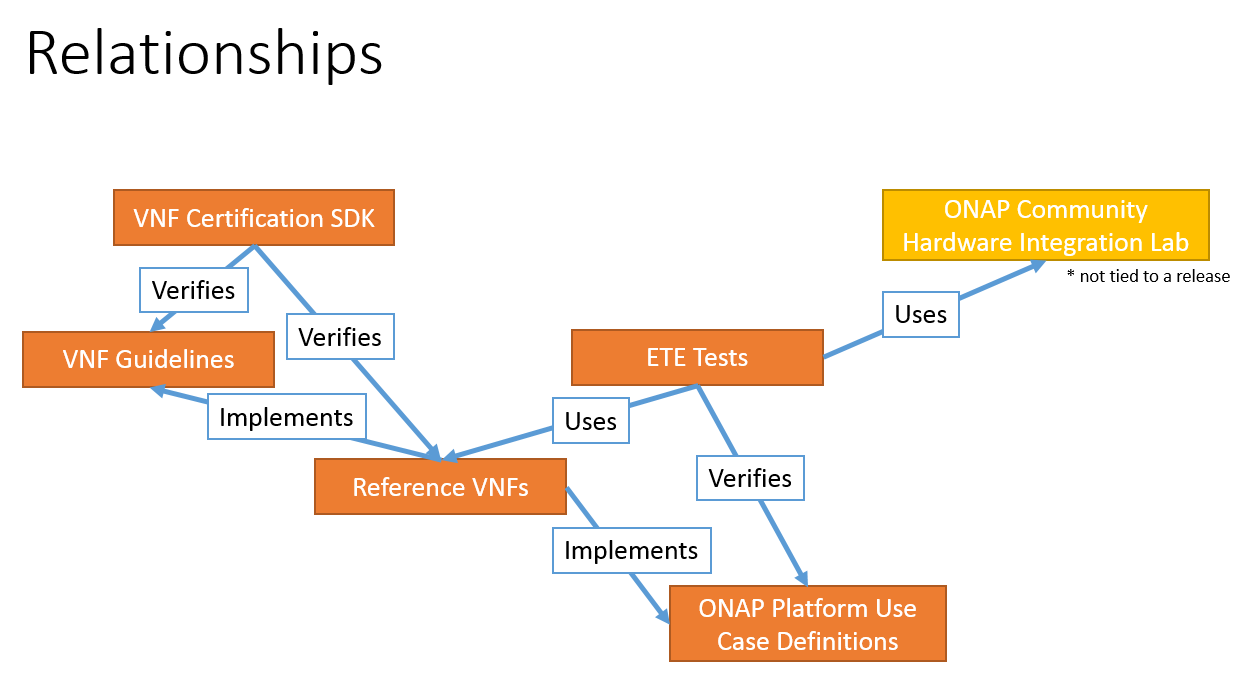Purpose
This template is to be used for the “Parallel Deep Dive Sessions to Align with architecture / Use cases” at the may ONAP developers event
Instructions.
The purpose of each section is to translate the use cases and functional architecture into specific identified needs for the components, and to identify potential projects to be proposed. There are three parts to this exercise:
- Identify needs based on the use case and architecture on this module, and potential dependencies on other modules or external artifacts.
- Group these into projects. Consider that coding, documentation, and testing is required. Include an initial scope for the project.
- If time, mapping the needs into the projects.
The need identification table has the following columns
- Identified need: <slogan for the identified need>
- Brief need description: <a few sentences describing the need>
- Driver:<Related use case or architecture change, if any>
- Dependencies:<identify dependencies on other modules or artifacts (e.g. other onap module, models, …)
- Project: <If time, after the projects are identified, suggest in which project the need would best fit>
Time keeping suggestion: The exercise time is 45 minutes. A good practice would be to split into 20 minutes on need identification and 20 minutes on project proposals.
Exercise output.
ONAP Meeting Session name: <insert onap module name>
Need Identification:
Identified Need | Description | Driver | Dependencies | Project fit |
| Identify the core use case vs the whole use case | we need to identify VNFs that fit in there | Use case finalization | ||
| Use cases that dont have open source vnfs in them need buy in from the vendpr | we need to make sure the vnfs are workable for our release | |||
| there is a desire to have open source vnfs where possible | ||||
| we need to pull out the commonality amongst the use cases and describe how we will abstract that out to the platform as a whole | ||||
| ECOMP controller should not e the only way to deploy onap. the need is there for various deployment scenarios - test, local development and production deployment |
Project proposals.
[repeat for each project. Note: This is not a complete project proposal skeleton, only sufficient enough for this discussion]
Project 1: VNF Certification
Project Name:
- VNF Certification
Project Description
- VNF Certification
Scope:
- Quickly identify scope, consider: documentation, APIs, models, testing, integration, functionality.
- Note of any particular deliverables to highlight.
- If anything is out of scope, not it down
Other:
- AT&T ICE Was offered
- this is the same as Project 3.
Project 2: VNF Guidelines
Project Name:
- VNF Guidelines
Project Description
- VNF Guidelines
Scope:
- Quickly identify scope, consider: documentation, APIs, models, testing, integration, functionality.
- Note of any particular deliverables to highlight.
- If anything is out of scope, not it down
Other:
- ECOMP and OPENO VNF Guidelines
Project 3: VNF SDK
Project Name:
- VNF SDK
Project Description
- VNF SDK
Scope:
- Quickly identify scope, consider: documentation, APIs, models, testing, integration, functionality.
- Note of any particular deliverables to highlight.
- If anything is out of scope, not it down
Other:
- OpenO VNF SDK
- This is the same as project 1
Project 4: Reference VNFs
Project Name:
- Reference VNFs
Project Description
- Reference VNFs
Scope:
- Quickly identify scope, consider: documentation, APIs, models, testing, integration, functionality.
- Note of any particular deliverables to highlight.
- If anything is out of scope, not it down
Other:
- we have 2 demo VNFs today
Project 5: ETE Tests
Project Name:
- ETE Tests
Project Description
- ETE Tests
Scope:
- Quickly identify scope, consider: documentation, APIs, models, testing, integration, functionality.
- Note of any particular deliverables to highlight.
- If anything is out of scope, not it down
Other:
- openecomp and openo have ete tests
Project 6: ONAP Platform Use Case Definitions
Project Name:
- ONAP Platform Use Case Definitions
Project Description
- ONAP Platform Use Case Definitions
Scope:
- Big areas are Change management, Orchestration, Instantiate, Closed Loop, these may be seperate projects
Other:
-
Project 7: ONAP Community Hardware Integration Lab
Project Name:
- ONAP Community Hardware Integration Lab
Project Description
- ONAP Community Hardware Integration Lab
Scope:
- Quickly identify scope, consider: documentation, APIs, models, testing, integration, functionality.
- Note of any particular deliverables to highlight.
- If anything is out of scope, not it down
Other:
-
Project 8: ONAP Deployment Management
Project Name:
- ONAP Deployment Management
Project Description
- ONAP Deployment Management
Scope:
- Quickly identify scope, consider: documentation, APIs, models, testing, integration, functionality.
- Note of any particular deliverables to highlight.
- If anything is out of scope, not it down
Other:
- ECOMP controller should not e the only way to deploy onap. the need is there for various deployment scenarios - test, local developement and production deployment
demo heat exists

4 Comments
Jason Hunt
Can you expand on the difference between Project 1 (VNF Certification) and Project 3 (VNF SDK)? My understanding was that the Open-O VNF SDK project covered onboarding and certification, not too dissimilar from AT&T ICE scope?
Daniel Rose
I dont know if there is a difference. I just wrote what was talked about.
Daniel Rose
i updated the diagram to reflect this
Roberto Kung
The reference VNFs is a key part of ONAP: every ONAP project will be able to 'play' with them. If a VNF supplier wants to ensure ONAP compliancy, it is important that the specifics of its VNF be 'represented' in the reference VNFs. As an operator, I would expect major VNFs supplier to make sure that the reference VNFs are useful to them, compatible with their own way to develop VNFs.